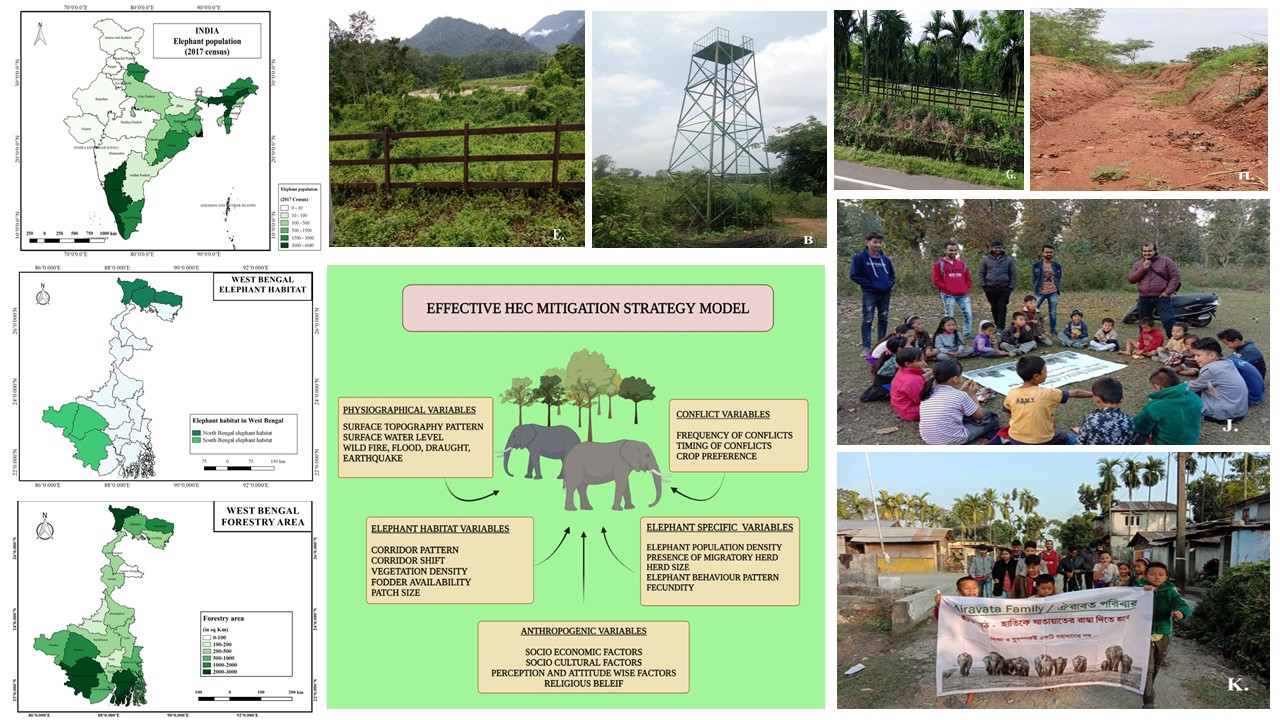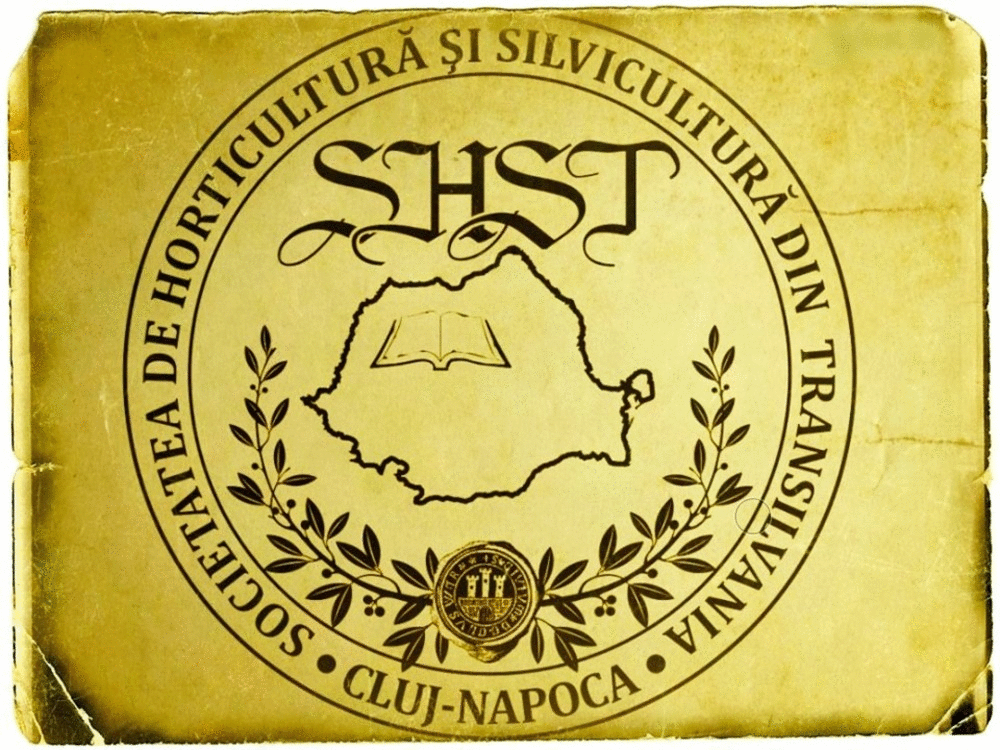Efficacy of different human-elephant conflict prevention and mitigation techniques practiced in West Bengal, India
DOI:
https://doi.org/10.15835/nsb13311017Keywords:
human elephant conflict (HEC), human wildlife conflict (HWC), mitigation techniques, mitigation measures, wildlife management, wildlife conservation, West Bengal, IndiaAbstract
Human-elephant conflicts (HEC) have become an ever-increasing threat to wildlife management in recent years around the world. In India, West Bengal has been one of the worst sufferers of these conflicts. With 2.89 % of the entire elephant population in India, the state records a high mortality rate, both human and pachyderm every year. Although several mitigation techniques, traditional as well as modern, have been used for many years, however, the conflict cases have not shown any steady decline. It seems that the measures practiced in the region focus on short-term alleviation rather than a long-lasting solution ensuring peaceful coexistence of the two species. The study discusses the mitigation and preventive measures of human-elephant conflicts practiced in the state, their efficacy and shortcomings. The study revealed a single “universal model” is not successful to mitigate the concerns; rather a combination of measures is required. An amalgamation of traditional and modern techniques is also suggested. An efficacious operative mitigation plan should be site-specific and based on several local factors including conflict, physiographical, habitat, anthropogenic and other such variables. Thus, a hypothetical model for designing an effective mitigation strategy has been proposed for future researchers and competent authorities to look into. This could be helpful for policy makers to plan effective management practices not only in the region but also elsewhere.
Metrics
References
Arakal RA (2021). Karnataka: ‘Fence of honeybees’ around village to reduce elephant-human conflict, The Indian Express. Retrieved 2021 June 22 from https://indianexpress.com/article/cities/bangalore/karnataka-fence-of-honeybees-around-village-to-reduce-elephant-human-conflict-7231328/
Aravind I (2019). With human-elephant conflict taking more lives on both sides, stakeholders are split over a sustainable solution. The Economic Times. Retrieved 2021 June 22 from https://economictimes.indiatimes.com/news/politics-and-nation/with-human-elephant-conflict-taking-more-lives-on-both-sides-stakeholders-are-split-over-a-sustainable-solution/articleshow/68337524.cms?from=mdr
Badola R, Ahmed T, Gill AK, Dobriyal P, Das GC, Badola S, Hussain SA (2021). An incentive-based mitigation strategy to encourage coexistence of large mammals and humans along the foothills of Indian Western Himalayas. Scientific Reports 11(1):1-13. https://doi.org/10.1038/s41598-021-84119-7
Banerjee A (2018). Addressing the elephant in South Bengal. Conservation India. Retrieved 2021 June 22 from https://www.conservationindia.org/articles/addressing-the-elephant-in-south-bengal.
Barua M, Bhagwat SA, Jadhav S (2013). The hidden dimensions of human–wildlife conflict: health impacts, opportunity and transaction costs. Biological Conservation 157:309-316. https://doi.org/10.1016/j.biocon.2012.07.014
Barua P, Bist SS (1995). Changing pattern in the distribution and movement of wild elephants in Northern Bengal. In: Daniel JC, Datye HS (Eds). A week with elephants. Bombay Natural History Society, Oxford University Press, Bombay, pp 66-83.
Basu S (2017). Conflict to co-existence: Securing Jharkhand-West Bengal interstate elephant corridor, India. Interim report. Retrieved 2021 May 22 from https://elephantconservation.org/iefImages/2017/03/Samya-Basu-India_Interim-Report-IEF-Project-2017-website.pdf
Bhadury T (2019). North Bengal: The new arena of man-elephant conflict in India. Retrieved 2021 June 22 from https://www.eastmojo.com/news/2019/11/29/north-bengal-the-new-arena-of-man-elephant-conflict-in-india/
Chakraborty K and Mondal J (2013). Perceptions and patterns of human–elephant conflict at Barjora block of Bankura district in West Bengal, India: insights for mitigation and management. Environment, Development and Sustainability 15(2):547-565. https://doi.org/10.1007/s10668-012-9392-2
Chakraborty S (2015). Human-animal conflicts in northern West Bengal: losses on both sides. International Journal of Pure Applied Bioscience 3:35-44.
Chakraborty S (2018). Perception and attitude of local people towards human-elephant conflicts around Mahananda wildlife sanctuary, West Bengal, India. International Journal of Zoological Studies 3(2):93-95.
Chatterjee ND (2016). Man-elephant conflict: a case study from forests in West Bengal, India. Springer International Publishing. https://doi.org/10.1007/978-3-319-31162-3
Das K (2015). Man elephant conflicts in North Bengal. Teri University 1-26. Retrieved 2021 May 5th from http://www.teriuniversity.ac.in/mct/pdf/assignment/Kalyan-Das.pdf.
Dasgupta S, Ghosh AK (2015). Elephant–railway conflict in a biodiversity hotspot: Determinants and perceptions of the conflict in Northern West Bengal, India. Human Dimensions of Wildlife 20(1):81-94. https://doi.org/10.1080/10871209.2014.937017
Doyle S, Groo M, Sampson C, Songer M, Jones M, Leimgruber P (2010). Human-elephant conflict–What can we learn from the news. Gajah 32:14-20.
Fernando P, Kumar MA, Williams AC, Wikramanayake E, Aziz T, Singh SM (2008). Review of human-elephant conflict mitigation measures practiced in South Asia. Gland, Switzerland: WWF.
FSI (2019). India state of forest report. Forest survey of India, Ministry of environment, forest and climate change, Government of India 2, 294-304. Retrieved 2021 June 2 from https://fsi.nic.in/forest-report-2019?pgID=forestreport-2019
Gubbi S (2020). Human-elephant conflict and its mitigation: QandA with Sanjay Gubbi. Conservation India. Retrieved 2021 June 22 from https://www.conservationindia.org/articles/man-elephant-conflict-and-its-mitigation-a-qa-with-sanjay-gubbi
INDIA P (2011). Census of India 2011 provisional population totals. Office of the Registrar General and Census Commissioner, New Delhi.
Kaggere N (2020). No end to conflict as humans and elephants tussle for space. Deccan Herald. Retrieved 2020 December 22 from https://www.deccanherald.com/specials/insight/no-end-to-conflict-as-humans-and-elephants-tussle-for-space-857200.html
Kshettry A, Vaidyanathan S, Sukumar R, Athreya V (2020). Looking beyond protected areas: Identifying conservation compatible landscapes in agro-forest mosaics in north-eastern India. Global Ecology and Conservation 22:e00905. https://doi.org/10.1016/j.gecco.2020.e00905
Kumar M (2021). Winds of change: new strategies to combat human-elephant conflict. Mongabay India. Retrieved 2021 June 2 from https://sustain.round.glass/conservation/human-elephant-conflict-odisha-chhatisgarh-forests/
Lahiri Choudhury DK (1980). An interim report on the status and distribution of elephants (Elephas maximus) in Northeast India. In: Daniel JC (Ed). The Status of the Asian Elephant in the Indian Sub-continent (IUCN/SSC Report). Pp 43-58.
Lenin J (2011). Human – elephant conflict. Conservation India. Retrieved 2021 September 3 from https://www.conservationindia.org/articles/human-elephant-conflict
Lenin J, Sukumar R (2011). Action plan for the mitigation of elephant–human conflict in India. Final Report to the US Fish and Wildlife Service. Asian Nature Conservation Foundation, Bangalore.
Mallick PH (2018). Trend of changes in annual forest cover of South West Bengal, India. International Journal of Zoology and Animal Biology 1(5):000130. https://doi.org/10.23880/izab-16000130
Mallick PH, Chakraborty SK (2018). Forest, wetland and biodiversity: revealing multi-faceted ecological services from ecorestoration of a degraded tropical landscape. Ecohydrology and Hydrobiology 18(3):278-296. https://doi.org/10.1016/j.ecohyd.2018.04.002
Mitra S (2017). Elephant mortality on railway tracks of Northern West Bengal, India. Gajah 46:28-32.
MOEF and CC (2017). Synchronized elephant population estimation India. Ministry of Environment, Forest and Climate Change, Government of India. Retrieved 2021 January 2 from http://www.indiaenvironmentportal.org.in/content/446218/synchronized-elephant-population-estimation-india-2017/
MoEF and CC (2020). International protection for Great Indian Bustard, Bengal Florican and Asian elephant. Retrieved 2021 January 2 from https://pib.gov.in/PressReleaseIframePage.aspx?PRID=1603895
Mondal J, Pahari DP (2019). Role of forest department in mitigating Human-Elephant Conflict: A case study of Bankura North Forest division, West Bengal. International Review of Social Sciences and Humanities 9(7):946-960
Naha D, Sathyakumar S, Dash S, Chettri A, Rawat GS (2019). Assessment and prediction of spatial patterns of human-elephant conflicts in changing land cover scenarios of a human-dominated landscape in North Bengal. PloS One 14(2):e0210580. https://doi.org/10.1371/journal.pone.0210580
Panda PP, Noyal T, Dasgupta S (2020). Best practices of human – elephant conflict management in India. Published by Elephant Cell, Wildlife Institute of India, Dehradun, Uttarakhand.
Pandit PK, Chanda S (2019). Human-elephant conflict and its possible control measures in South West Bengal Land Scape, India. Indian Forester 145(10):911-920.
Panja U, Mistri B (2018). Human-elephant conflict in Sonamukhi CD Block of Bankura District, West Bengal. Space and Culture, India 5(3):106-128.
Rangarajan M, Desai A, Sukumar R, Easa PS, Menon V, Vincent S, Prasad AN (2010). Gajah. Securing the future for elephants in India. Retrieved 2020 July 22 from http://www.environmentandsociety.org/node/2697
Roy M, Sukumar R (2015). Elephant corridors in Northern West Bengal. Gajah 43:26-35.
Roy M (2017). A Spatial and temporal analysis of elephant-human conflict at Gorumara and Jalpaiguri Forest Divisions of Northern West Bengal. Journal of Wild Life Research 5:41-49.
Roy M, Sukumar R (2017). Railways and wildlife: A case study of train-elephant collisions in northern West Bengal, India. Railway ecology. Springer, Cham pp 157-177
Roy M, Baskaran N, Sukumar R (2009). The death of jumbos on railway tracks in northern West Bengal. Gajah 31:36-39.
Saha SK (2020). Innovative way of human-elephant competition mitigation. Journal of Threatened Taxa 12(11):16494-16501. https://doi.org/10.11609/jott.5886.12.11.16494-16501
Santiapillai C (1987). Translocation of elephants in Lampung, Sumatra. IUCN/SSC Asian Elephant Specialist Group Newsletter 2:15-20.
Santra AK, Samanta AK, Pan S (2007). Measures adopted to combat migratory elephants in South West Bengal forests. Gajah 27:42-47.
Sarkar B, Ara J, Chanda U, Chatterjee S, Pain M (2016). A device to minimize human-elephant conflict. International Journal of Scientific and Engineering Research 7(4):29-36.
Shaffer LJ, Khadka KK, Van Den Hoek J, Naithani KJ (2019). Human-elephant conflict: A review of current management strategies and future directions. Frontiers in Ecology and Evolution 6:235. https://doi.org./10.3389/fevo.2018.00235
Singh AK, Singh RR, Chowdhury S (2002). Human-elephant conflicts in changed landscapes of south West Bengal, India. Indian Forester 128(10):1119-1132.
Sukumar R (1991). The management of large mammals in relation to male strategies and conflict with people. Biological Conservation 55(1):93-102.
Sukumar R (2003). The living elephants: evolutionary ecology, behaviour and conservation. Oxford University Press, New York.
Sukumar R, Venkataraman A, Cheeran JV, Mujumdar PP, Baskaran N, Dharmarajan G, Narendran K (2003). Study of elephants in Buxa Tiger Reserve and adjoining areas in northern West Bengal and preparation of conservation action plan. Submitted to West Bengal Forest Department under India Eco‐development Project. Centre for Ecological Sciences, Indian Institute of Science, Bangalore, India.
Tiwari SK, Poddar A, Ramkumar K (2017). Elephant corridors of Northern West Bengal. In: Menon V, Tiwari SK, Ramkumar K, Kyarong S, Ganguly U, Sukumar R (Eds). Right of Passage: Elephant Corridors of India. [2nd Edition]. Conservation Reference Series No. 3. Wildlife Trust of India, New Delhi 2:314-423
Treves A, Wallace RB, White S (2009). Participatory planning of interventions to mitigate human–wildlife conflicts. Conservation Biology 23(6):1577-1587. https://doi.org/10.1111/j.1523-1739.2009.01242.x
Venkataraman AB, Saandeep R, Baskaran N, Roy M, Madhivanan A, Sukumar R (2005). Using satellite telemetry to mitigate elephant–human conflict: an experiment in northern West Bengal, India. Current Science 1827-1831.
Vibha G, Lingaraju HG, Venktaramana GV (2021). Effectiveness of solar fence in reducing human-elephant conflicts in Manchahalli village, Mysuru, Karnataka, India. Current Science 120(4):707-711.
WBAFR (2018). West Bengal Annual State Forest Report. Government of West Bengal, Directorate of Forests, Office of the Principal Chief Conservator of Forests and Head of Forests Force, Aranya Bhaban, Salt Lake, Kolkata. Retrieved 2020 June 5 from http://www.wildbengal.com/admin_wildlife/upload/3286Annual_Report%202017-18.pdf
WBAFR (2019). West Bengal Annual State Forest Report. Government of West Bengal, Directorate of Forests, Office of the Principal Chief Conservator of Forests and Head of Forests Force, Aranya Bhaban, Salt Lake, Kolkata. Retrieved 2021 January 15 from http://www.wildbengal.com/admin_wildlife/upload/7427annual_report-18-19.pdf
Wildlife SOS (2019). Chhattisgarh Wild Elephant Collaring Project: An attempt to collar the Tuskers. Retrieved 2021 May 22 from https://wildlifesos.org/elephant/chhattisgarh-wild-elephant-collaring-project-an-attempt-to-collar-the-tuskers/
Williams C, Tiwari SK, Goswami VR, de Silva S, Easa PS, Kumar A, Baskaran N, Yoganand K, Menon V (2020). Elephas maximus. IUCN Red List of Threatened Species 2020 e.T7140A45818198.

Downloads
Published
How to Cite
Issue
Section
License
Papers published in Notulae Scientia Biologicae are Open-Access, distributed under the terms and conditions of the Creative Commons Attribution License.
© Articles by the authors; licensee SMTCT, Cluj-Napoca, Romania. The journal allows the author(s) to hold the copyright/to retain publishing rights without restriction.
License:
Open Access Journal - the journal offers free, immediate, and unrestricted access to peer-reviewed research and scholarly work, due SMTCT supports to increase the visibility, accessibility and reputation of the researchers, regardless of geography and their budgets. Users are allowed to read, download, copy, distribute, print, search, or link to the full texts of the articles, or use them for any other lawful purpose, without asking prior permission from the publisher or the author.













.png)















